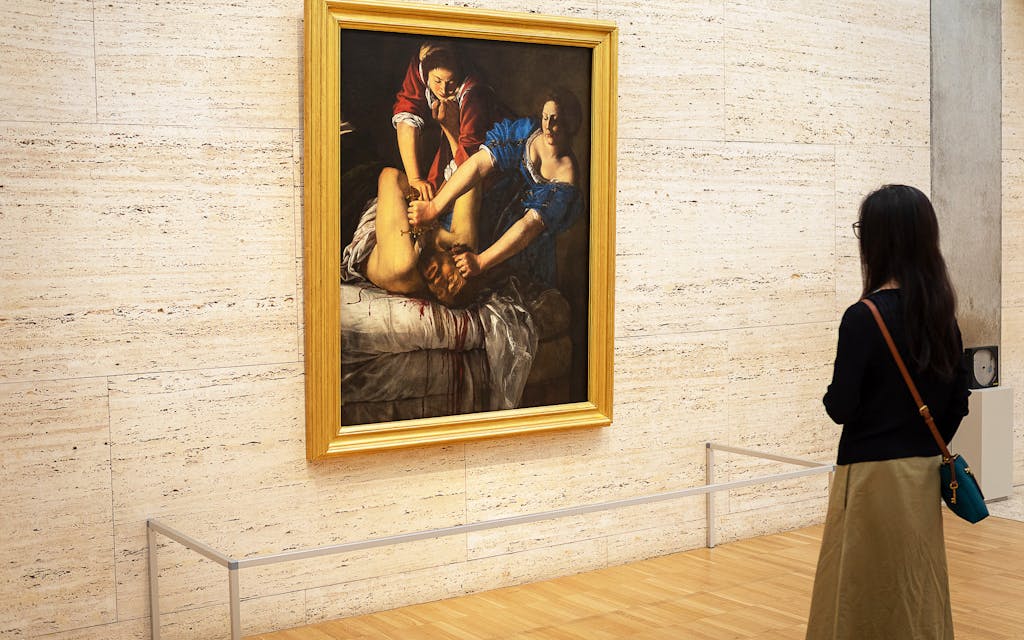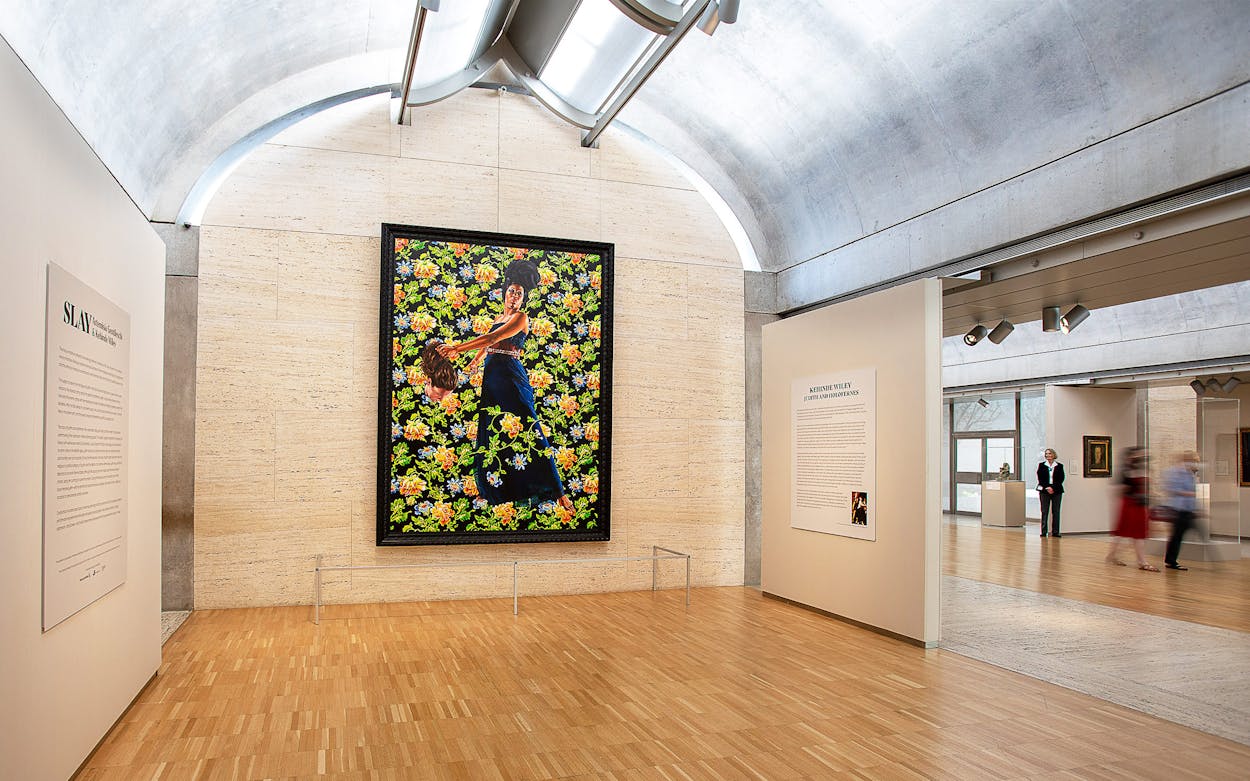Fort Worth’s Kimbell Art Museum is well-known as a treasury of old masters. Regular museumgoers identify it with the famous Caravaggio and Georges de La Tour card cheats, the first known painting by Michelangelo, and many more. But right now, as you enter the European galleries, which normally house nothing more recent than a late Matisse, your eyes are drawn to an enormous, vivid twenty-first-century painting. It’s by a Black American born in the 1970s, and it depicts a regal and commanding modern Black woman. Thrillingly, it almost seems to preside over this section of the museum. If you want to stroll through the collection chronologically, you’ll have to reckon with this work before you start in on all the Madonnas, landscapes, and portraits of the powerful. Its provocations might adjust your thinking on that last category.
This visitor, Kehinde Wiley’s Judith and Holofernes (2012), is here as half of a two-painting special exhibition, “Slay: Artemisia Gentileschi & Kehinde Wiley,” on view through October 9. The show is small in footprint but big in impact. Wiley’s Judith hangs with another gorgeous work on the same subject, made exactly four hundred years earlier by an artist who also broke barriers: Judith and Holofernes (1612–1617), by Artemisia Gentileschi. The two face each another, alone together in a gallery. The Wiley is almost eleven feet tall, the Gentileschi a bit smaller but still monumental. It seems fitting that you can’t compare them side by side. You are forced to turn your body a full 180 degrees to give each, in turn, the attention it commands.
The paintings depict the biblical story of Judith, a woman who liberates her Jewish town by cunningly tricking the Assyrian general Holofernes into believing she wants to help him defeat the Israelites, then beheading him with his own sword. Many artists have made works based on the story, tempted by its theme of a woman vanquishing a vastly more powerful man. Artists have chosen one of two ways to depict the action: with Judith in mid-struggle, in the act of cutting (Donatello, Gentileschi), or triumphantly holding up the head of Holofernes after the grisly deed is done (Titian, Lucas Cranach the Elder, and now Wiley).
Gentileschi, an Italian Baroque painter born in Rome in 1593, led a dramatic life that was well chronicled and gives us moderns many reasons to admire her. As a teen, she was raped by artist Agostino Tassi, an associate of her father, who was also a successful painter. We have detailed accounts of the sensational trial that ensued, which lasted for months (Tassi was convicted in 1612, and Gentileschi began her Judith the same year). “We know much more about her daily life than we do about other artists,” says Nancy Edwards, curator of European art at the Kimbell. That can lead viewers to make the mistake of reducing Gentileschi’s art to autobiography, but Edwards cautions against seeing her Judith paintings (there are several) and the rest of her work solely as an angry, revengeful response to the rape and women’s circumstances in the seventeenth century. “Give her her own agency as someone who had a lot of ambition, a lot of resolve, and a tremendous amount of artistic creativity,” Edwards says. She “had a forceful personality and led an amazing life” in other ways too, teaching herself to read and write, composing poetry, and having the force of will to learn to paint at such a high level and to land patronage and commissions that enabled her to be successful in Rome, Venice, Naples, and London—almost unheard-of for a woman. Edwards calls attention to choices that help make this Judith and Holofernes so alive and immediate—the effort of the second strong woman holding Holofernes down, the pinwheel effect of all the arms in the composition, the drama of the chiaroscuro.
Before he painted his Judith, Kehinde Wiley had become known for a series of works in which he showed young Black men in heroic poses borrowed from the old masters. He let his subjects—chosen through “street casting” from people he saw around New York City—help select the inspiration paintings and showed them just as they were. One early subject was shown sitting confidently atop a horse in Napoleon’s pose from a famous Jacques-Louis David painting, but wearing Timberland boots, camo pants, and a bandanna. Wiley grew up in California, where as a child he visited galleries such as the Huntington library and museum and noticed that he never saw people like him up on the walls. The Yale-trained artist hit on this portraiture idea early in his career and quickly found an eager public. Famously, Barack Obama chose him to paint his official presidential portrait, which shows some Wiley trademarks, including a leafy background with tendrils that break their plane and encroach upon the sitter.

In Wiley’s Judith and Holofernes, the background is a repeating botanical motif with busy orange and blue flowers that looks like Grandma’s wallpaper. Wiley may have multiple reasons for using these flat (but throbbing and creeping!) backdrops instead of versions of the original scenes. But one effect is to yada yada all that—the subject gets thrust forward even more. This larger-than-life-size Judith is part of the artist’s first series devoted to female subjects. He was thinking about women in his life, who of course also never see themselves in galleries of old pictures. Here, he also cast models from the street, but instead of having them pose in their own clothes, he worked with former Givenchy designer Riccardo Tisci to clothe them in high-end fashion, evoking the wealthy subjects in traditional portraiture. Wiley’s Judith is sleek in a blue strapless gown, resplendent with her hair piled high and her eyeshadow turned up to eleven. I got a jolt when I noticed that the severed head is that of a woman, though I recognize that it likely landed a particular way because I am a woman (and, further, she is white, as am I). “Both of these paintings are shocking, but in very different ways,” Edwards says. She gestures to the Gentileschi. “This is a physically shocking painting.” You feel the struggle to hold Holofernes down, the difficulty of cutting off the head, the man’s terror. “And this,” she says, turning toward the Wiley, “is much more cerebral.”
Yes, Wiley’s Judith immediately makes you ask questions and think beyond the frame (which, by the way, is pointedly not gilt but painted a deep black). Your mind swirls with thoughts about race, about beauty, about who gets to make art and who gets to pose for it, and those linger as you move through the rest of the galleries. Wiley led me pretty far from the Bible tale. With Gentileschi’s painting, I took in the whole drama and felt invited to study many elements in the scene: the powerful arms and resolute faces of Judith and her maid, two women who immediately impress the viewer; Holofernes, with his face heavily shadowed, almost obscured, and the bloodied cloth beneath him; and the sumptuous colors of the seventeenth-century dresses—almost a guilty pleasure when you’re looking at such a violent scene.
Wiley’s portrait treatment, which focuses on Judith the woman and her achievement, shifted my attention much more to Judith the heroine. Or is this entirely a modern-day heroine? The maid is gone, and even the severed head, with a lingering matter-of-fact expression on the face, was something I almost had to go looking for among the mad foliage. It seems to belong more to the background. (Wiley used a studio assistant as its model, maybe reinforcing its prop status.) Judith is staring fiercely right at me from above, and my feelings are about her as a presence—so like women I see every day—and not so much the act she’s just committed.
Fort Worth has become the leading place to see Kehinde Wiley’s work in Texas. The Modern Art Museum of Fort Worth led the way in 2008 with a small exhibit, one of Wiley’s earliest museum shows, after which it acquired his Colonel Platoff on his Charger (2007). In 2015, it was the sole Texas stop for the larger exhibition “Kehinde Wiley: A New Republic,” the artist’s first career retrospective, which included Judith and Holofernes. Gentileschi’s Judith has been in Fort Worth before too, as part of a Kimbell exhibit of works from the Capodimonte Museum in Naples, Italy, in 2020. The Capodimonte allowed one of its most important works to travel here again because it “would like the wonderful Gentileschi painting to be better known,” says Edwards.
The Kimbell has long placed parts of its collection in dialogue with contemporary art, inviting artists to bring in their own works and lead events in the galleries, helping us see something old in a new way. You can always walk across Van Cliburn Way to the Modern to create such a conversation for yourself. But this summer, the Kimbell forces you to contemplate the old and the new at once, doing 180 turns to appreciate a female Baroque-era genius and a model from today’s streets, in all their imposing glory.
- More About:
- Art
- Fort Worth








